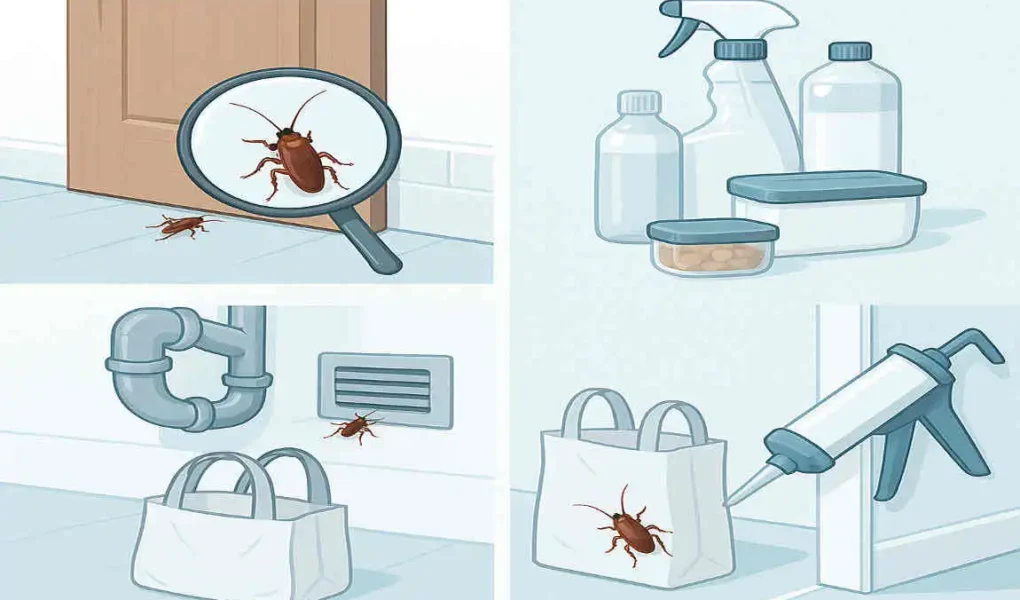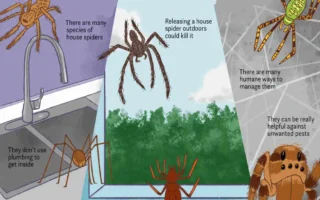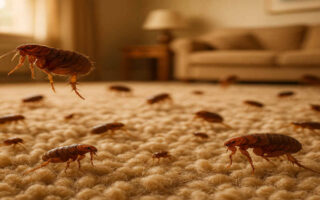Imagine this: you’re relaxing at home when you spot a cockroach scurrying across your kitchen floor. It’s a moment that sends shivers down your spine and leaves you wondering, “How did this happen?” Well, you’re not alone. Cockroach infestations are a common problem for many homeowners. But don’t worry, we’re here to help you understand how these pesky critters get into your house and provide you with expert cleaning tips to prevent future infestations.
Understanding Cockroaches and Their Behavior
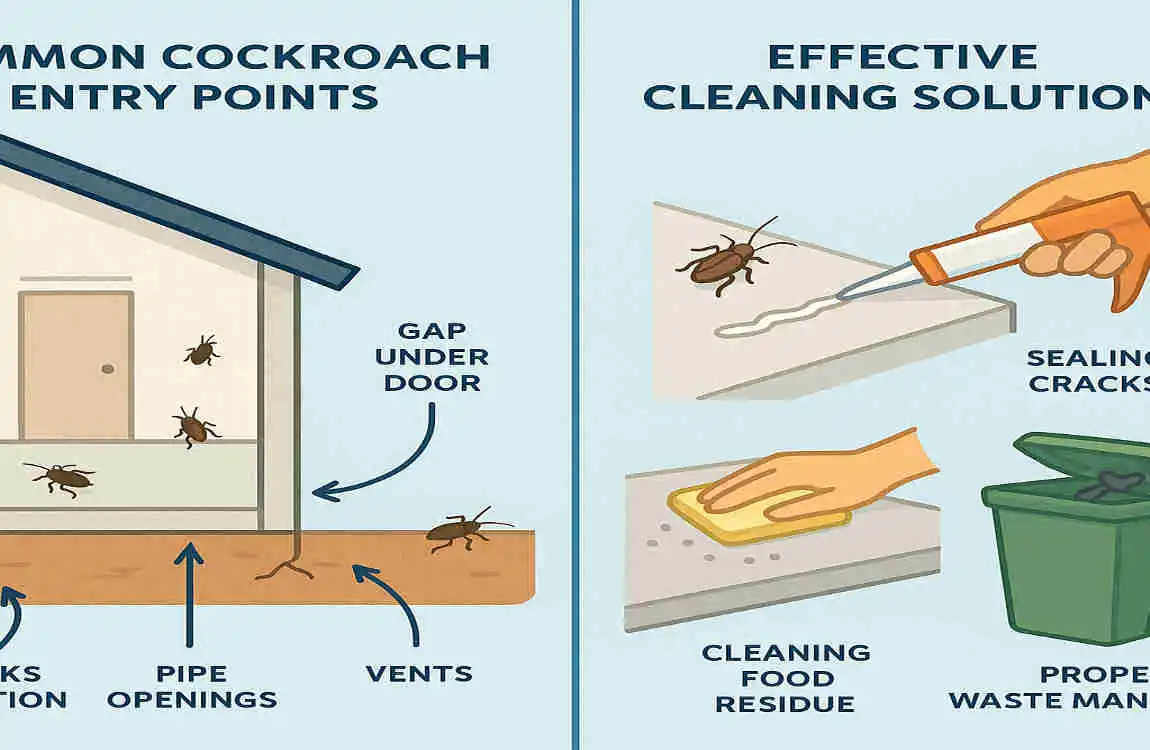
Common Cockroach Species in Homes
Before we delve into how clean cockroaches get into your house, let’s take a moment to familiarize ourselves with the common species you might encounter. The two most common cockroaches in homes are the German cockroach and the American cockroach.
- German Cockroach: These small, light brown cockroaches are notorious for infesting kitchens and bathrooms. They’re known for their rapid reproduction and ability to hide in tight spaces.
- American Cockroach: Larger than their German counterparts, American cockroaches are reddish-brown and often found in basements, sewers, and other damp areas. They’re attracted to food sources and can spread quickly throughout a home.
Cockroach Habits and Survival Instincts
Cockroaches are incredibly resilient creatures with a strong Survival instinct. They’re nocturnal, preferring to hide during the day and forage for food at night. These pests are attracted to warmth, moisture, and food sources, which is why they often seek shelter indoors.
One of the most fascinating aspects of cockroach behavior is their ability to squeeze through tiny spaces. They can flatten their bodies to fit through cracks as narrow as a credit card, making it easy for them to enter your home.
Why Cockroaches Seek Shelter Indoors
So, why do cockroaches choose to invade our homes? The answer lies in their basic needs: food, water, and shelter. Our homes provide an ideal environment for cockroaches, offering a constant supply of the resources they need.
During colder months, cockroaches are drawn to the warmth of our homes. They’ll seek out cracks and crevices near heating vents or appliances to stay cozy. In warmer months, they may be attracted to the moisture found in bathrooms, kitchens, and basements.
How Cockroach Behavior Influences Entry Points
Understanding cockroach behavior is key to identifying potential entry points in your home. Their ability to squeeze through tight spaces means that even the smallest gap can serve as an invitation for these pests.
Cockroaches are also skilled climbers, capable of scaling walls and ceilings to reach their desired destinations. This means that entry points aren’t limited to ground level; they can enter through upper floors or even the roof if given the opportunity.
Common Entry Points for Cockroaches in Homes
Now that we have a better understanding of cockroach behavior, let’s explore the common entry points they use to infiltrate our homes.
Cracks and Crevices in Walls and Foundation
One of the most common ways cockroaches enter homes is through cracks and crevices in walls and foundations. These small openings may seem insignificant to us, but to a cockroach, they’re like open doors.
Over time, the wear and tear on a home can lead to cracks and gaps. Settling foundations, temperature fluctuations, and general aging can all contribute to these entry points. It’s essential to regularly inspect your home’s exterior and interior walls for cracks or crevices that could invite cockroaches inside.
Gaps Around Doors and Windows
Another common entry point for cockroaches is gaps around doors and windows. These pests can easily slip through even the smallest of openings, so it’s crucial to ensure that your doors and windows are properly sealed.
Weather stripping is an effective way to prevent cockroaches from entering through gaps around doors. By applying a tight seal, you can significantly reduce the risk of these pests entering your home. Similarly, checking window screens for holes or tears and repairing them promptly can help keep cockroaches out.
Plumbing and Utility Openings
Cockroaches are notorious for using plumbing and utility openings as entry points into homes. Pipes, vents, and drains can all serve as highways for these pests, allowing them to travel from one area to another.
It’s essential to regularly inspect the areas around your plumbing and utility openings. Look for any gaps or cracks that could give cockroaches easy access to your home. Sealing these openings with caulk or expanding foam can help prevent infestations.
Unsealed Gaps in Basements and Attics
Basements and attics are prime entry points for cockroaches. These areas often have unsealed gaps and cracks that can serve as entryways for pests.
In basements, pay close attention to the areas around windows, doors, and utility openings. Sealing these gaps can help prevent cockroaches from entering your home from below. In attics, check for gaps around vents, chimneys, and rooflines. By addressing these potential entry points, you can significantly reduce the risk of a cockroach infestation.
Delivery of Infested Items/Packages
Believe it or not, cockroaches can hitch a ride into your home through the delivery of infested items or packages. These pests are known for hiding in cardboard boxes, grocery bags, and even furniture.
When receiving deliveries, it’s a good idea to scrutinize the items before bringing them inside. Look for any signs of cockroach activity, such as droppings or shed skins. If you suspect that an item may be infested, it’s best to leave it outside and contact the seller for a replacement.
How Cockroaches Hitch Rides Inside Bags, Boxes, and Appliances
Cockroaches are opportunistic creatures that will take advantage of any chance to find shelter and food. They can easily hitch a ride into your home inside bags, boxes, and even appliances.
Grocery bags and cardboard boxes are common hiding spots for cockroaches. These pests are attracted to the food residue and warmth that these containers provide. When bringing groceries or packages into your home, be sure to scrutinize them and dispose of any bags or boxes promptly.
Appliances, such as refrigerators and dishwashers, can also serve as hiding spots for cockroaches. These pests may enter your home through the appliance’s ventilation system or by crawling along the power cord. When purchasing new appliances, it’s a good idea to inspect them thoroughly before bringing them into your home.
How Cockroaches Get Into My House?
Now that we’ve explored the common entry points for cockroaches, let’s take a closer look at how these pests actually get into your house.
Detailed Explanation Connecting Entry Points to Common Infestations
Cockroaches are incredibly skilled at finding their way into homes through various entry points. Once they’ve gained access, they’ll quickly establish a foothold and begin to multiply.
The most common scenario is that cockroaches enter through a small crack or gap in the exterior of your home. From there, they’ll explore their surroundings, searching for food, water, and shelter. As they move deeper into your home, they’ll leave behind pheromone trails that attract other cockroaches and lead them to the same entry point.
Over time, what may have started as a single cockroach can quickly turn into a full-blown infestation. These pests reproduce rapidly, with a single female capable of producing hundreds of offspring in her lifetime. If left unchecked, a small problem can quickly spiral out of control.
Movement Patterns and Crawling Habits of Cockroaches
To understand how cockroaches get into your house, it’s helpful to understand their movement patterns and crawling habits. These pests are incredibly agile and can move quickly across various surfaces.
Cockroaches are known for their ability to crawl along walls and ceilings, allowing them to navigate your home with ease. They’ll often follow the edges of rooms, using baseboards and moldings as guides. This behavior can help them find potential entry points and food sources.
When it comes to crawling, cockroaches are incredibly efficient. They can move at up to 3 miles per hour, making it easy for them to cover long distances in search of resources. This speed, combined with their ability to squeeze through tight spaces, makes them formidable pests.
Seasonal Tendencies and Environmental Factors Influencing Entry
Cockroach activity can vary with the season and other environmental factors. Understanding these tendencies can help you anticipate and prevent infestations.
During warmer months, cockroaches are more active and may be more likely to enter your home in search of food and water. They’re attracted to the moisture found in kitchens, bathrooms, and basements, making these areas prime targets for infestations.
In colder months, cockroaches may seek shelter indoors to escape the cold. They’ll often enter through cracks and crevices near heating vents or appliances, drawn to the warmth and humidity found inside your home.
Environmental factors, such as humidity and temperature, can also influence cockroach activity. These pests thrive in warm, moist environments, so areas with high humidity may be more prone to infestations. By controlling the temperature and humidity levels in your home, you can make it less attractive to cockroaches.
Real-Life Examples or Case Studies of Infestation Triggers
To illustrate how cockroaches get into homes and the factors that can trigger infestations, let’s take a look at a couple of real-life examples.
The Kitchen Infestation
A family noticed an increasing number of cockroaches in their kitchen, particularly around the sink and cabinets. Upon investigation, they discovered that a small gap around the kitchen window had been serving as an entry point for the pests. The family had been storing food in open containers on the counter, providing an easy food source for the cockroaches. By sealing the gap and implementing better food storage practices, the family eliminated the infestation.
The Basement Invasion
A homeowner found cockroaches in their basement, especially around the water heater and along the baseboards. It turned out that a crack in the foundation had been allowing the pests to enter from outside. The damp, dark basement environment provided an ideal habitat for cockroaches. By sealing the crack and improving ventilation in the basement, the homeowner prevented further infestations.
These case studies demonstrate how small entry points and environmental factors can lead to cockroach infestations. By addressing these issues and implementing preventative measures, you can significantly reduce the risk of these pests invading your home.
Expert Cleaning Tips to Prevent Cockroach Infestations
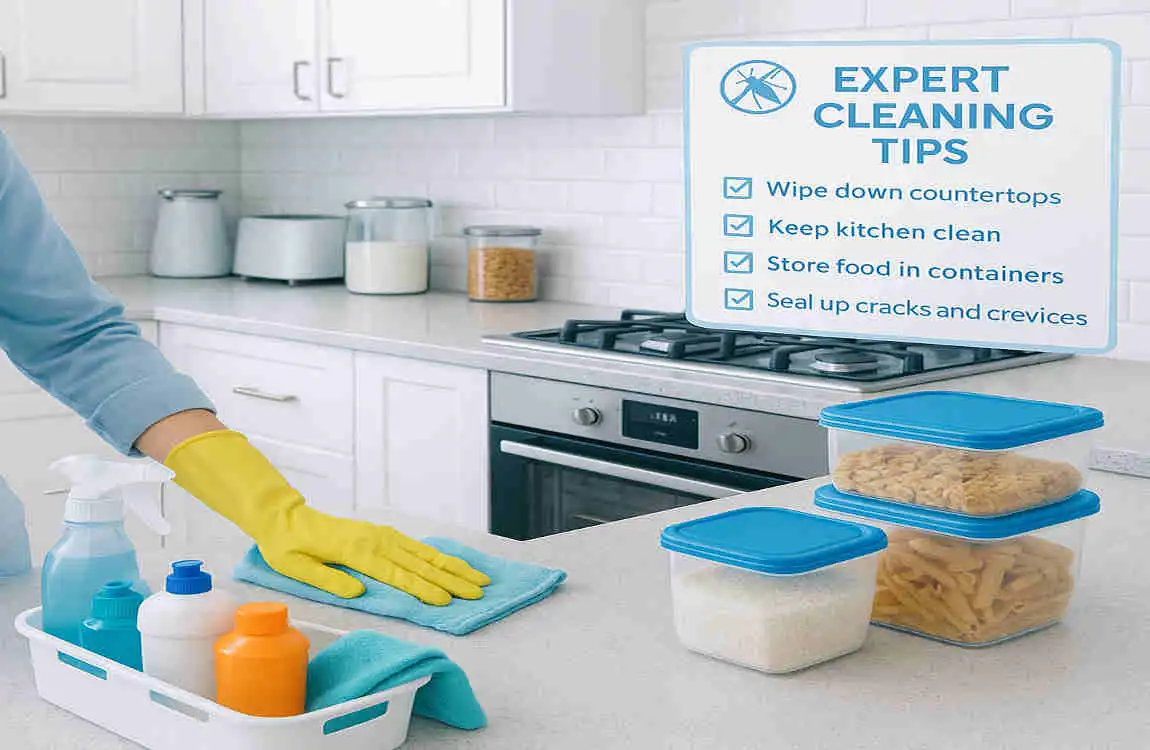
Now that we’ve explored how cockroaches get into your house, let’s discuss some expert cleaning tips to help you prevent infestations.
Importance of Regular Deep Cleaning and Sanitation
One of the most effective ways to prevent cockroach infestations is through regular deep cleaning and sanitation. By keeping your home clean and free of food debris, you can make it less attractive to these pests.
Deep cleaning involves more than just a quick tidy-up. It means getting into all the nooks and crannies of your home, including areas that may be easily overlooked, such as behind appliances and under furniture. Use a vacuum cleaner with a crevice tool to reach these tight spaces and remove any crumbs or debris that could attract cockroaches.
Sanitation is equally vital in preventing infestations. This means regularly disinfecting surfaces, especially in the kitchen and bathroom, where food and moisture are present. Use a mild bleach solution or a commercial disinfectant to wipe down countertops, sinks, and other areas where cockroaches may be attracted.
How to Remove Food and Water Sources That Attract Cockroaches
Cockroaches are drawn to homes in search of food and water. By removing these sources, you can make your home less appealing to these pests.
Start by storing food in airtight containers, rather than leaving it out on the counter or in open bags. This includes pet food, which can be a major attractant for cockroaches. Clean up any crumbs or spills immediately, and don’t leave dirty dishes in the sink overnight.
Regarding water sources, fix any leaky faucets or pipes that may be providing moisture for cockroaches. Empty pet water bowls at night and wipe down sinks and bathtubs to remove any standing water. By eliminating these sources of food and water, you can significantly reduce the risk of a cockroach infestation.
Proper Waste Management and Disposal Techniques
Proper waste management and disposal are crucial for preventing cockroach infestations. These pests are attracted to the smell of garbage, so it’s essential to keep your trash contained and disposed of properly.
Use trash cans with tight-fitting lids to prevent cockroaches from accessing your waste. Empty your trash regularly, especially if you have food scraps or other organic matter in the bin. Keep your outdoor trash cans clean and away from your home’s foundation to reduce the risk of attracting cockroaches.
When disposing of waste, be sure to seal bags tightly and tie them closed. This will help prevent cockroaches from getting inside and spreading throughout your home. If you have a compost pile, keep it well-maintained and away from your home to avoid attracting these pests.
Cleaning Tips to Target Typical Cockroach Hiding Spots
Cockroaches are notorious for hiding in dark, secluded areas of your home. By targeting these typical hiding spots, you can help prevent infestations and keep your home cockroach-free.
Start by cleaning behind and under appliances, such as refrigerators, stoves, and dishwashers. Use a vacuum cleaner with a crevice tool to reach these tight spaces and remove any crumbs or debris that could attract cockroaches.
Next, focus on cabinets and drawers, especially in the kitchen and bathroom. Wipe down the interior surfaces with a mild bleach solution or a commercial disinfectant to remove any food residue or grease that may be attracting cockroaches. Don’t forget to clean the undersides of shelves and the tops of cabinets, as these areas can also harbor pests.
Finally, pay attention to baseboards, moldings, and other areas where cockroaches may be hiding. Use a vacuum cleaner or a damp cloth to remove any dust or debris that could be providing shelter for these pests. By targeting these typical hiding spots, you can help prevent cockroach infestations and keep your home clean and pest-free.
Using Natural Repellents and Cleaning Agents Safely
If you’re looking for a more natural approach to preventing cockroach infestations, several options are available. Natural repellents and cleaning agents can be effective at deterring these pests without harsh chemicals.
One popular natural repellent is diatomaceous earth, a fine powder made from the fossilized remains of tiny aquatic organisms. When cockroaches come into contact with diatomaceous earth, it can damage their exoskeletons, causing them to dehydrate and die. Sprinkle diatomaceous earth in areas where cockroaches are likely to travel, such as along baseboards and behind appliances.
Another natural option is boric acid, a white powder that can create a barrier against cockroaches. When cockroaches walk through boric acid, it sticks to their bodies and can be ingested when they groom themselves. Over time, this can lead to the cockroach’s death. Apply boric acid to cracks and crevices where cockroaches are likely to hide, but keep it out of reach of children and pets.
When using natural repellents and cleaning agents, always follow the manufacturer’s instructions and take necessary safety precautions. Keep these products out of reach of children and pets, and avoid inhaling or ingesting them. By using natural options safely, you can help prevent cockroach infestations while minimizing your exposure to harsh chemicals.
When and How to Use Cockroach Baits and Traps Effectively
In some cases, you may need to use cockroach baits and traps to help control an infestation. These products can be effective at attracting and eliminating cockroaches, but it’s essential to use them correctly for the best results.
Cockroach baits work by attracting pests with a food-based lure, then delivering a slow-acting poison that they carry back to their nests. Place bait stations in areas where cockroaches are likely to travel, such as along baseboards, behind appliances, and in cabinets. Be sure to follow the manufacturer’s instructions and replace the bait as needed.
Cockroach traps, on the other hand, work by luring the pests into a sticky surface or a container from which they cannot escape. Place traps in areas where cockroaches are known to be active, such as in the kitchen or bathroom. Check the traps regularly and dispose of any captured cockroaches promptly.
When using cockroach baits and traps, it’s essential to be patient. These products may take several weeks to eliminate an infestation, as cockroaches need time to carry the poison back to their nest and spread it to other members of the colony. By using baits and traps effectively, you can help control cockroach infestations and prevent future outbreaks.
Structural and Preventive Measures
In addition to cleaning and sanitation, there are several structural and preventative measures you can take to help keep cockroaches out of your home.
Sealing Cracks, Gaps, and Holes Effectively
One of the most critical steps in preventing cockroach infestations is to seal any cracks, gaps, and holes in your home’s exterior and interior. These small openings can serve as entry points for cockroaches, so it’s crucial to address them promptly.
Start by inspecting the exterior of your home, focusing on the foundation, walls, and roofline. Look for any cracks or gaps that could be providing access for cockroaches. Use high-quality caulk or expanding foam to seal these openings, following the manufacturer’s instructions for best results.
Next, move inside your home and inspect the walls, baseboards, and moldings for any cracks or gaps. These areas can also serve as entry points for cockroaches, so be sure to seal them effectively. Use a caulk gun to apply a bead of caulk along the length of the crack or gap, smoothing it out with a damp cloth or your finger.
By sealing cracks, gaps, and holes effectively, you can significantly reduce the risk of cockroach infestations and keep your home pest-free.
Maintenance Strategies for Plumbing and Drainage Systems
Cockroaches are notorious for using plumbing and drainage systems as entry points into homes. By correctly maintaining these systems, you can help prevent infestations and keep your home cockroach-free.
Start by regularly inspecting your plumbing and drainage systems for any signs of leaks or damage. Fix any issues promptly to prevent moisture buildup, which can attract cockroaches. Use a plunger or a drain snake to clear any clogs that may be providing a food source for these pests.
Next, consider installing screens or filters on your drains to prevent cockroaches from entering your home. These devices can be purchased at most hardware stores and easily installed in your sink, bathtub, and floor drains. By keeping your plumbing and drainage systems well-maintained, you can help prevent cockroach infestations and keep your home clean and pest-free.
Installing Door Sweeps and Window Screens
Another effective way to prevent cockroach infestations is to install door sweeps and window screens. These simple devices can help keep cockroaches out of your home by blocking their entry points.

